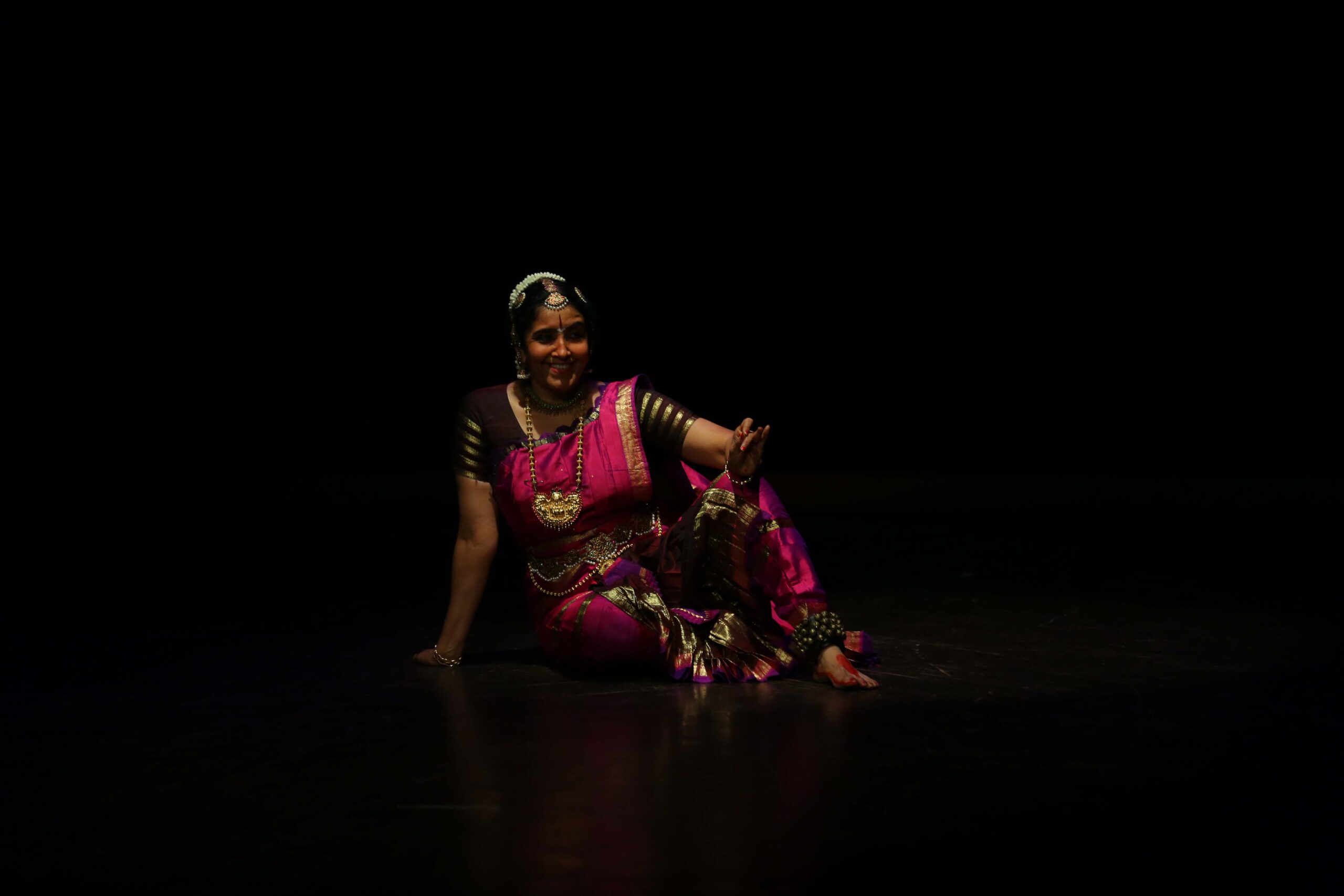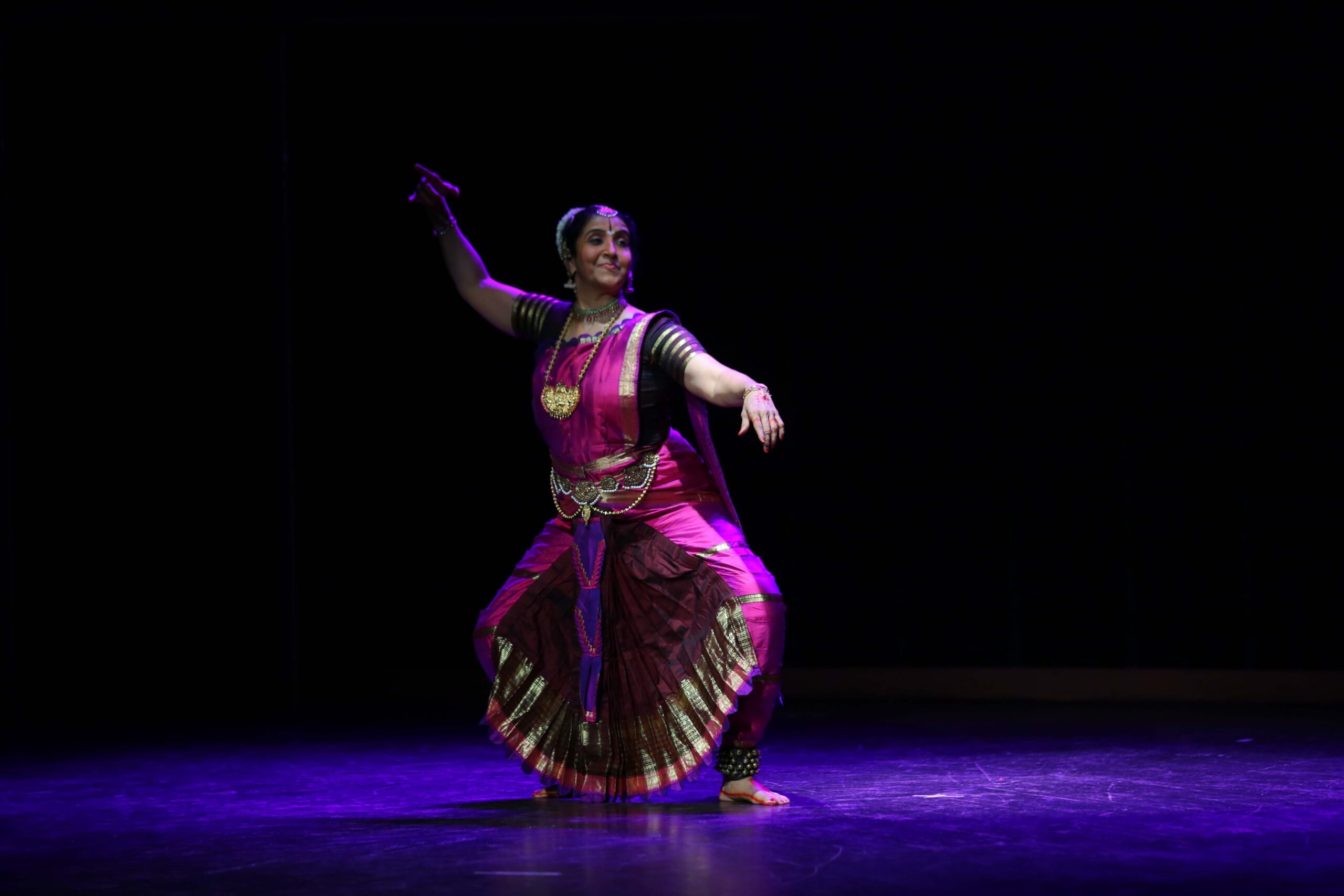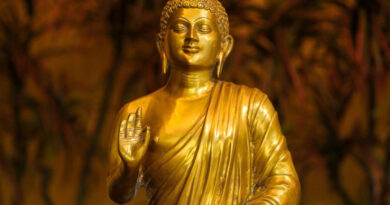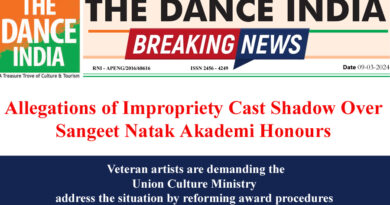Bala Devi Chandrashekar’s Brihadeeswara: From Form to Formless
Text: Dr Sunil Kothari
Bala Devi Chandrashekar from Princeton, New Jersey is a renowned exponent of Bharatanrityam, having studied from Dr Padma Subrahmanyam. She has choreographed several mythological themes including Karna to the music composed by Rajkumar Bharathi. During my visit to Princeton four years ago I had an opportunity to see it. She is an industrious artist, working on similar themes over the past several years.

Recently her latest choreography of Brihadeeswara – form to formless, through the eyes of a Devaradiyaal was presented at Habitat Centre to the recorded music with assistance from SPIC MACAY.
The performance was on a vast canvass in four acts, taking the audience on a journey into the life and mind of a Devaradiyaal, a devotee of Lord Brihadeeswara. She describes the magnificent temple in its architectural majesty. After offering prayers to Lord Ganapathi and Murugan, Devaradiyaal introduced the great King Raja Raja Cholan, his family, the architect of the temple Veerachola Kunjara Mallan, five entrance portals and the passage around the sanctum.
Bala Devi has taken help from the renowned archaeologist Dr Nagaswamy and other great scholars, has made a deep study of the daily rituals observed in the temple and has enriched her performance with excellent lyrics set to exquisite ragas and talas. Therefore the appeal of these lyrics to the cognoscenti is greater than to the general audience.
The presentation further expounds upon Lord Shiva’s precession in Mallari, chanting of Panchakshara Om Namah Shivaya and Devaradiyaal enters the sanctum sanctorum. The priest requests her to light the kuddavilakku and then only the puja is completed.
In the second act, she begs of Lord to show her the cosmic dance in which Uma keeps the tala, and she is overwhelmed watching its cosmic beauty. The indescribable divine dance is performed with exquisite grace.
Follows the third act in which Devaradiyaal sees the Lord in form of Lingam. Bala Devi has introduced sanchari of Vishnu taking the form of a boar and Brahma that of a swan to measure the infinite form of illuminating Lingam. The lyrics devoted to the Lord as Sadashiva inspires Devaradiyaal in her mind to envisage the dance of Ardhanarishwara.
When she ascends the first Vimana of the temple, the priest shows her the Karana sculptures of the Lord. Bala Devi has used sollus to perform few of the Karanas and Angaharas. The sollus she has retrieved from the family of the last practitioner of it from Thiruvarur.
In the final and fourth act, a sequence is choreographed where the gipsies are shown singing the praise of Raja Chola who gives them gifts. They extol his deeds for building this magnificent temple. The highlight of the production is when Devaradiyaal sees the fresco in which the dancing devotee gets lost watching the dance and her soul merges with the divine soul. Devaradiyaal surrenders herself to the cosmic god having seen the vision of Brihadeeswara in terms of from form to formless.
Leela Venkataraman, my confrere, critic and I were before the end of the presentation was asked to give comments on the production. In Leela Venkataraman ’s family, great scholars have written several historical volumes, on the Chola Kingdom. She explained the significance of the production. Dr Venkataraman, her husband who has written on Life and Times of Raja Raja Chola, has drawn attention to the salient features of the literary and architectural aspects of the temple. Leela explained the importance of that fresco, the painting of Devaradiyaal who finds moksha in the end and not the Brahmin priest. It is the supreme act of benediction of God. Leela complimented Bala Devi for her extraordinary research work and artistic presentation.
I referred to my learning about the Karanas on the first floor of the temple, for the first time, during All India Dance Conference held in 1958 in Delhi by SNA when K Vasudev Shastri mentioned it. When I visited the great temple later on, for research and for my book on Bharatanatyam, I saw the Karanas for the first time thanks to Dr Nagaswamy, who had given me a letter on the archaeological department, so that we could also photograph the Karanas.
Bala Devi has used those Karanas and combination of the Karanas into Angaharas in her choreography artistically. However, what was very touching was her dancing as a devotee that appealed to all, whether they understood the lyrics or not.
For this production, Bala Devi told me that she had received guidance from many scholars. Compilation of material by scholars Dr TN Ramachandran and Dr Kudavayil Balasubramanian, script was prepared by Dr TN Ramachandran, music by Rajkumar Bharathi, Vedic chants were mixed by Sai Shravanam of Resounding India, vocals by H Ananthanarayanan and Keerthana Vaidyanathan, mridangam, nattuvangam and jathis by Vijayaraghavan Govindachary, jathis rendition by Jayashree Ramanathan and Kaushik Champakesan, tabla and percussion by Ganapathi ,veena by Bhavani, violin by Embar Kannan, and flute by Vishnu.
Such production demands teamwork over a long period of gestation.
It is not a production that can be enjoyed easily. I did make some notes whenever the compère spoke, but it is not easy to remember or write down names while listening. Fortunately, Bala Devi sent me the synopsis in detail with four acts, which has helped me to write in detail.
This brings me back to the importance of giving in the advance synopsis to the audience with details of all musicians and other relevant information, which the audience can read before the programme starts. The compere may explain well, but written text one can take home and also read later on and try to understand if things remain incomprehensible.
Bala Devi would do well to distribute the printed synopsis. It is an additional cost in terms of money. But it would be worth spending money to publish a brochure which has these details.
Today’s audience is diverse and all do not know Tamil lyrics. I realised that in the audience there were dancers who knew Tamil, knew also the story, perhaps vaguely, but non-Tamil speaking audience misses a lot when things are not explained in simple language. It was by fortuitous circumstance that we had someone like Leela Venkataraman with us, who had the great advantage of knowing so much about Brihadeeswara, Chola kings and she also knew lyrics. Her appreciation made the audience aware of the need for such information which would go a long way in making this production accessible to the general mass.
Before I close this review, I would like to complement Bala Devi for undertaking this production in dance. I am sure when she would reflect; she might find it necessary to edit it to a suitable length. Too many references make the production difficult to follow. Of course, the music by someone like music maestro Rajkumar Bharathi helps in carrying forward the narration with Bala Devi’s expertise in dance. Perhaps it is difficult to edit it as music is recorded. But with experts who can help, Brihadeeswara dance work would gain by editing and making it more accessible.




